 |
 |
|
|
|
  |
| > Chuo Ward Toppage > Attractions / The land mark and
a historic spot, a historical walk way |
Landmarks and Historic Locations
Uno Koji Literary Monument
In Nakaoe Park, 2, Itoyamacho 2-Chome, Chuo-ku, Osaka |
Uno Kooji (1891-1961) was born in Fukuoka City but moved
to Osaka at the age of four. In 1919 he published Kura
no Naka andKu no Sekai and established.his position as
an author.
Later he wrote so many books that he was known as the
"literary devil."The works known as the Osaka books
such as Seijuro Yume Miru Ko, Hashi no Ue, and Yujo,
depict a unique world. His monument is in Naka Ooe Park
in Itoya Cho, the world where he spent his early boyhood
and depicted in romantic prose novels like Seijuro Yumi
Miru Ko.
|
 |
Naoki Sanjugo Literary Monument
Side to Enokidai Meijin, 3, Yasutojicho 2-Chome, Chuo-ku, Osaka |
Ueki Sanjugo (1891-1934)was born in Osaka, his real name
being Uemura Shuuichi. At the age of 3l he adopted the
pen name Ueki Sanjuichi, thereafter changing it annually
a digit at a time until he finally settled on Sanjugo.
He attended a university in Tokyo, and after the great
Kanto earthquake was part of the coterie that founded
Bungei Shunju, including Kikuchi Kan Akutagawa Ryunosuke,
and Kume Masao. He then returned to Osaka.
Nankoku Taiheiki, which was published as a newspaper
was a novel that took as its subject the rebellion of
the Satsuma clan: It drew in simple style. a picture
of the troubled times at the end of the Tokugawa period,
and was hailed as a masterpiece that sent a fresh breath
of air through popular literature. After his death the
Ueki Prize was established in his memory. The monument
was set up near to his birthplace on a hilly road in
Yasutoji Cho.
|
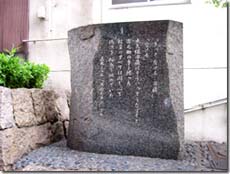 |
Takeda Rintaro Literary Monument
In front of Seiganji Gate, 1, Kamihommachinishi 4-Chome, Chuo-ku, Osaka |
Takeda Rintaro (1904-1946)established his position as
a novelist with Booryoku, iand thereafter produced works
freely using new techniques. His Ihara Saikaku was said
to be a work in which he employed the life and movements
of Saikaku, also Osaka-born, to speak about himself and
to look closely at his own life. The monument is erected
in the precincts of Saigangi.
|
 |
Saikaku Literary Monument
4, Hommachibashi, Chuo-ku, Osaka |
Ihara Saikaku (1642-1692) was born in Osaka, and together
with Chikamatsu Monzaemon and Matsuo Bashoo ranks as one
of the flowers that blossomed in the Genroku literary
period. He published his Koshoku Ichidai Otoko in 1682,
and established an immovable place.in floating world fiction.
|
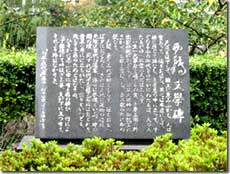 |
Usuda Kyukin Literary Monument
In Higashi Daira-kita Park, 1, Kamihommachi-Nishi, 4-Chome, Chuo-ku, Osaka |
Usuda Kyushu (1877-1945 was born in Okayama Prefecture,
but came to Osaka at the age of 24 published literary
magazines and verse collections,. and gained a reputation
as a poet of the symbolic school. "Kingosan no Uta". Was
written when the author was temporarily residing in Honchoji
Temple.,and on his morning walks would see Katsuragi Peak
in the distance.bathed and shining in the morning light.
The emotion he would feel provided the inspiration for
the poem
The monument is erected in Higashi Daira Kita Koen
in the neighbourhood of Tanimachi. Where he was living
about the time this poem was written.
|
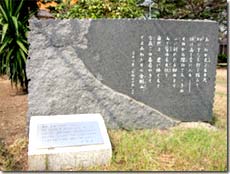 |
Tanizaki Junichiro Literary Monument
East side of The National Bunraku Theater of japan, 6, Nihombashi 1-Chome, Chuo-ku, Osaka
Shunkinsho Monument
In Sukunahikona Temple, 1, Doshucho, 2-Chome, Chuo-ku, Osaka |
Tanizaki Junichiro (1886-1965) was born in Tokyo, but
moved to Kansai after the Great Kanto Earthquake. He was
attracted by the customs.and traditional cultureof Kansai,and
his interest deepened in purely Japanese and classical
themes, giving rise to the group of famous.works such
as"Manji"A"Tade ku -mushi""Shunkinsho" belonging
to his middle period.
"Tade ku-mushi"produced five years
after his move to Kansai. Is a work that showed his
change to a return to the classics, and the monument
depicting the scene of his enjoying Bunraku was erected
on the west side of the National Bunraku Theater as
the Theater's own monument. "Shunkinsho", which borrows
Doshu Cho as its stage, and depicts his deep affection
for his wife Matsuko, is a prominent classic in modern
Japanese literature.and the monument stands in Sukunahikona
Jinja.
|
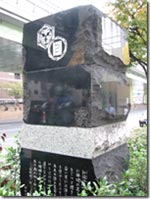 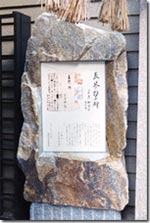 |
|
Ota Sakunosuke Literary Monument
In Hozenji Temple Yokocho, 7, Dotonbori 1-Chome, Chuo-ku, Osaka |
Ota Sakunosuke (1913-1947)was born in Osaka, and followed an individual path as playwright of the new school and as ? In 1939his Zokushu was a candidatefor the Akutagawa prize and the following year his Meoto-zenzai received high evaluation as representative of the Osaka school.
After the war too he produced works one after another such as Ropakukinsei and ? and he was termed a second Saikaku. His
works which are so typical of Osaka, and depict so skillfully the delicate nuances of the Osakan nature make the name of Ota imperishable. The monumenr was erected in 1963by connections and friends of Ota Sakunosuke beside Hozenji Temble whch appears in Meoto-zenzai.
|
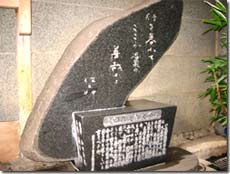 |
|
 |
|
 |
|
 |
